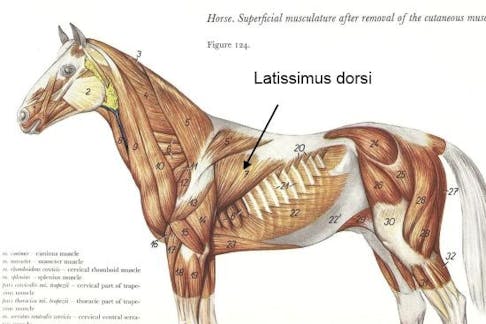The latissimus-dorsi muscle, often referred to as the "lats," is present in horses, just like in humans and other mammals. Here is some information about the latissimus-dorsi muscle in horses:
the Location and Anatomy:
The latissimus-dorsi muscle is a large, broad muscle located on the lateral (outer) side of the horse's back. It extends from the thoracic and lumbar vertebrae to the upper arm bone (humerus). In horses, the latissimus dorsi muscle is situated deep to other muscles, such as the trapezius and rhomboideus muscles.
what is the Function:
The primary function of the latissimus dorsi muscle in horses is to adduct and extend the forelimb. It assists in pulling the limb backward during extension and plays a role in the downward phase of the forelimb movement. Additionally, the latissimus-dorsi muscle provides support and stability to the horse's trunk and back during various movements.
the Development and Strength:
The latissimus-dorsi muscle is highly developed in horses, particularly in those that engage in activities requiring significant forelimb power, such as jumping or pulling heavy loads. The muscle's strength and development are influenced by factors such as genetics, exercise, and training. Proper conditioning and targeted exercises can enhance the latissimus dorsi muscle's strength and contribute to the horse's performance.
what is the Clinical Significance:
The latissimus-dorsi muscle can be a site of soreness or muscle tension in horses, especially if they are carrying excessive weight or experiencing poor saddle fit. Issues such as muscle strains or trigger points in the latissimus dorsi muscle may result in discomfort, reduced range of motion, or altered movement patterns. Proper management, including regular veterinary care, balanced training, and appropriate saddle fitting, can help prevent or address such issues.
The latissimus dorsi muscle is an integral component of the horse's musculoskeletal system, contributing to their locomotion, stability, and overall athletic ability.
Here are two additional facts about the latissimus-dorsi muscle in horses:
what is the Role in Galloping?:
The latissimus dorsi muscle plays a crucial role in the propulsion and balance of horses during galloping. As the forelimbs push off the ground and extend forward, the contraction of the latissimus-dorsi muscle assists in pulling the limb backward, generating power and propelling the horse's body forward.
the Connection to the Saddle:
The latissimus-dorsi muscle is closely related to the saddle placement on a horse's back. Improper saddle fit or positioning can lead to pressure points or discomfort in the latissimus dorsi muscle, causing issues such as soreness, muscle tension, or even lameness. Ensuring a well-fitted saddle and regular assessment of the horse's back can help prevent saddle-related problems and maintain the health of the latissimus dorsi muscle.
These additional facts provide further insight into the role of the latissimus dorsi muscle in horses' galloping and its connection to saddle fit and comfort
horses latissimus-dorsi info...

dorsal serrated info
Musculus serratus dorsalis caudalis:
The caudal dorsal serrate muscle (Serratus dorsalis caudali) is a muscle that originate from the thoracolumbar fascia caudally and attach by a series of individual digitations to the ribs lateral of the iliocostal muscles. . Origin: Thoracolumbar fascia.
What is serratus dorsalis caudalis muscle?
Serratus dorsalis caudalis muscle - vet-Anatomy - IMAIOS
Definition. The caudal dorsal serrate muscle (Serratus dorsalis caudali) is a muscle that originate from the thoracolumbar fascia caudally and attach by a series of individual digitations to the ribs lateral of the iliocostal muscles.
What is the action of the serratus dorsalis caudalis?
Action: Lift the ribs for inspiration.\
The "musculus serratus dorsalis caudalis" is a muscle in the horse's anatomy, also known as the caudal serratus dorsalis muscle. Here are some facts about this muscle:
Location and Function:
The musculus serratus dorsalis caudalis is located on the dorsal (back) aspect of the horse, extending from the withers to the lumbar region. It is a thin, sheet-like muscle that runs parallel to the vertebral column. The primary function of this muscle is to assist in the elevation and stabilization of the horse's ribcage during respiration.
Anatomy and Attachment:
The musculus serratus dorsalis caudalis originates from the spinous processes of the thoracic and lumbar vertebrae. From there, it inserts into the caudal (rear) edges of the horse's ribs, specifically from the ninth thoracic rib to the last lumbar rib.
Role in Movement:
The caudal serratus dorsalis muscle plays a role in the horse's movement and overall biomechanics. It works in conjunction with other muscles of the back and trunk to provide stability and control during various activities, such as carrying a rider, jumping, or performing lateral movements.
It's important to note that while these facts provide a general understanding of the musculus serratus dorsalis caudalis in horses, specific details or considerations may vary among individual horses. If you require more detailed or specific information, consulting an equine anatomy reference or seeking the expertise of a veterinarian or equine professional would be advisable.



